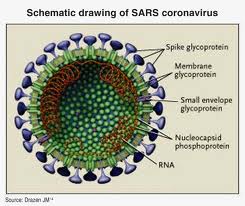What is SARS? SARS is a new strain of an acute flu that leads to a high fever, a severe cough and an atypical pneumonia where the inflammation of the lung tissue caused by this new type of virus leads to a severe lung infiltration that can be detected with chest X-rays. Cases similar to SARS have been known to the medical profession for several decades under the name of “atypical viral pneumonia”.
Most viruses lead to a laryngotracheitis, affecting only the lining of the upper airways like the trachea and the voice box. However, SARS is not like this. It is a new strain of virus that goes right down into the lung tissue and leads to more severe breathing problems from secretions that plug the airsacs (alveoli) of the lungs. However, only about 3% to 4% of patients who get SARS actually die as explained in the links below (see CDC and WHO Internet sites). Here is a brief review explaining the evidence in the medical literature that is known at this time (April 2003). Since March 2003 it is known that SARS likely is transmitted by a small virus belonging into the same family of viruses like measles or mumps (the Paramyxoviridiae family of viruses). This WHO link explains this in more detail. However, Dr. Francis Allan Plummer from the National Microbiology Lab in Winnipeg/Canada has isolated a human metapneumo virus in six out of 8 specimens from high suspicion cases for SARS that were submitted to the Lab. It is at present not clear whether there are only one or perhaps two or three similar viruses that may work in concert in tricking the immune system not to mount an immune response in some susceptible persons whereas in the majority of patients the immune system produces enough antibodies to overcome the disease.
In a publication from the New England Journal of Medicine, which was released one month early on Apr.10,2003, the SARS working group noted that there has been a corona virus isolated from 18 SARS patients who died from this disease 10 to 14 days into it and that this was a new strain of virus, which likely originated from a single ill health care worker from the Guangdong Province in China. These researchers used genetic tests (reverse transcription- polymerized chain reaction), electron microscopic tests of cell cultures with throat swabs from infected SARS patients as well as immunological tests with group specific corona virus antibodies to pinpoint the cause of SARS.
The new name for this virus: Urbani SARS-associated coronavirus in honor of Dr. Carolo Urbani, a WHO investigator who died of SARS himself when he investigated the early epidemic in Asia.
There might be inborn (genetic) weaknesses in some patients. The National Institute of Health is developing a vaccine against the corona virus, which is thought to trigger SARS. At the present time the best therapy is isolation in a hospital for those who are very sick with a possible combination treatment with corticosteroids and antiviral antibiotics, which may be 70% effective in halting the disease. The most important point is prevention of further transmission by isolation procedures (quarantine). Hopefully there will be a vaccine available soon, which could possibly be incorporated into the Flu vaccine.
More information in Dr. Schilling’s Nethealthbook: http://nethealthbook.com/infectious-disease/infectious-disease-infections/severe-acute-respiratory-syndrome/
Here is a link to the official CDC site about SARS
This link brings you to the World Health Organization site (WHO) where SARS is discussed.
Last edited October 25, 2014






